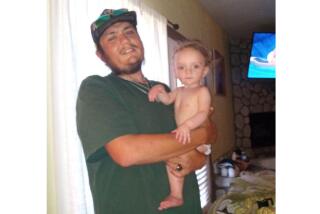Minor Injuries Can Reveal Signs of Child Abuse
- Share via
ORANGE — Bruises and other soft-tissue injuries in small children can be as strong an indicator of physical abuse as broken bones, according to a study by an orthopedic surgeon at UCI Medical Center.
In the study, published in a major medical journal, Dr. Patrick McMahon asks that bone specialists take note of less severe injuries as signs of other problems.
McMahon said his study might not be news to those who specialize in children’s health, but it is significant for doctors whose specialty might allow them to overlook some signs of abuse not commonly taught when they were in medical school 10 or 15 years ago.
“What the teaching always stressed before was that child abuse was identified by long bone fractures, bleeds in the head and more severe injuries, which are present and are found easily,” McMahon said of his study, recently published in the Journal of Bone and Joint Surgery.
“However, we’ve now learned to identify the more subtle indications of child abuse.”
McMahon’s study found that while certain injuries such as broken bones have long been indicators of physical abuse, multiple bruises and burns can be equally strong indicators that a child has been beaten.
“For individuals in pediatric emergency rooms and on hospital death review committees, that’s been part of the awareness pattern for some time,” said Dr. Astrid Heger, a professor at USC and a nationally recognized expert on child abuse. “But it’s exciting that it got into the primary journal for orthopedists--especially since they are often asked by private patients to see children.
“Now we need to be sure that these same kinds of articles get in the radiology journals and other consultant journals,” Heger said.
Of 371 children examined at UCI who doctors suspected had been physically abused, less than 10% were found to have bone fractures, but 92% had soft-tissue injuries, such as bruises or burns, according to the study. The study did not find whether the children actually had been abused--a legal determination that can be made only by the courts.
Also, the study did not include children who were suspected of having been sexually abused, emotionally abused or neglected.
McMahon, who began his research in 1987, said he was moved to study signs of physical abuse after he treated a little girl with a fractured bone in her leg and bruises. He said his follow-up questions convinced him that the injury was no accident.
“It turns out that she was [abused], and I filed a report on it,” he said. “But I became afraid I’d almost missed this case.”
Missing subtle forms of abuse is not hard to do.
“You have to look at the whole constellation of the injury,” said Lori Marshall of Children’s Hospital of Orange County. Marshall coordinated the hospital’s recent forum on child abuse that drew doctors and children’s experts from across the county.
“When a child comes in, are the injuries over the area where you would normally expect? Is the caretaker’s story consistent with the child’s developmental abilities?
“But in general as a society we need to look at the concept of child victimization and not just abuse,” Marshall said. “We tend to compartmentalize issues of neglect or abuse and other things occurring as being separate entities, and they’re not. They’re part of a whole environment.”





